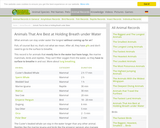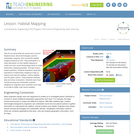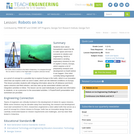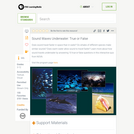
Comprehensive list of records and explanatory background information
- Subject:
- Life Science
- Zoology
- Material Type:
- Reading
- Date Added:
- 12/12/2018

Comprehensive list of records and explanatory background information

With this submission, students would use the underwater/waterproof capabilities of the camera to conduct studies and observations of the scientific properties and reactions of water.

In this 15 minute video, students will learn about the factors that contributed to the 2008 Great Recession. This video will aid in the comprehensive understanding of various standards as it relays cause(s) and effect of the Recession.

The marine environment is unique and requires technologies that can use sound to gather information since there is little light underwater. The sea-floor is characterized using underwater sound and acoustical systems. Current technological innovations are allowing scientists to further understand and apply information about animal locations and habitat. Remote sensing and exploration with underwater vehicles allows scientists to map and understand the sea floor, and in some cases, the water column. In this lesson, the students will be shown benthic habitat images produced by GIS. These imaged will lead to a class discussion on why habitat mapping is useful and how current technology works to make bathymetry mapping possible. The teacher will then ask inquiry-based questions to have students brainstorm about the importance of bathymetry mapping.

This course introduces theoretical and practical principles of design of oceanographic sensor systems. Topics include: transducer characteristics for acoustic, current, temperature, pressure, electric, magnetic, gravity, salinity, velocity, heat flow, and optical devices; limitations on these devices imposed by ocean environments; signal conditioning and recording; noise, sensitivity, and sampling limitations; and standards. Lectures by experts cover the principles of state-of-the-art systems being used in physical oceanography, geophysics, submersibles, acoustics. For lab work, day cruises in local waters allow students to prepare, deploy and analyze observations from standard oceanographic instruments.

Students learn about humankind’s search for life in outer space and how it connects to robotics and engineering. NASA is interested in sending exploratory missions to one of Jupiter’s moons, Europa, which requires a lot of preparatory research and development on Earth before it can happen. One robot currently being engineered as a proof of concept for a possible trip to explore Europa is the Icefin, which is an innovative robot that can explore under ice and in water, which are the believed conditions on Europa. This lesson provides students with intriguing information about far off (distance and time!) space missions and field robotics, and also sets up two associated robotics and arts integration activities to follow. The lesson can be used individually to provide new information to students, or as a precursor to the associated activities. A PowerPoint® presentation and worksheet are provided.

This interactive quiz from the NOVA Web site features an array of interesting facts about the nature of sound underwater.